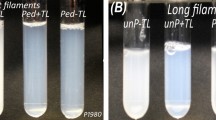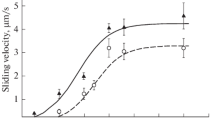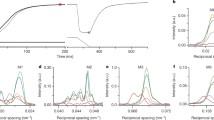Abstract
We measured the relative sliding velocity of cardiomyopathic hamster cardiac myosin on actin cables by using anin vitro motility assay system. We also investigated the relationship between the velocity and both myosin isozyme content and ATPase activity. Cardiac myosin was obtained from cardiomyopathic hamsters (BIO 14.6;B) aged 3,6,9, and 18 months and age-matched controls (F1B;F). Long well-organized actin cables of an alga,Nitellopsis, wer used for the motility assay. Small latex beads (2 μm in diameter) were coated with purified cardiac myosin. When myosin-coated beads were introduced into an algal cell in the presence of Mg-ATP, myosin interacted with actin and dragged the beads. Active movement of the beads along the actin cables was observed under a photomicroscope and the velocity was measured. The velocity was significantly lower in B than in F for each age group (0.47 vs. 0.71 μm/s at the age of 3 months, p<0.05; 0.44 vs. 0.88 μm/s at 6 months, p<0.01; 0.44 vs. 0.67 μm/s at 9 months, p<0.01; 0.35 vs. 0.52 μm/s at 18 months, p<0.05). Both Ca2+-activated ATPase activity and the percentage of α-myosin heavy chain were also lower in B than in F for each age group. When examined for individual specimens, there was a positive correlation between the velocity and both myosin Ca2+-activated ATPase activity (r=0.84) and percentage of α-myosin heavy chain (r=0.83). These data points of both control and cardiomyopathic hamsters were distributed near the regression line obtained from control and thyroxine-treated rabbits reported previously. The present results indicate that the difference in mechanical properties between control and cardiomyopathic cardiac myosin is attributed to isozyme redistribution and not to a qualitative change in each myosin molecule.
Similar content being viewed by others

References
Wagner JA, Weisman HF, Snowman AM, Reynolds IJ, Weisfeldt ML, Snyder SH: Alterations in calcium antagonist receptors and sodium-calcium exchange in cardiomyopathic hamster tissues. Circ Res 65: 205–214, 1989
Rouleau JL, Chuck LHS, Hollosi G, Kidd P, Sievers RE, Wikman-Coffelt J, Parmley WW: Verapamil preserves myocardial contractility in the hereditary cardiomyopathy of the Syrian hamster. Circ Res 50: 405–412, 1982
Kagiya T, Hori M, Iwakura K, Iwai K, Watanabe Y, Uchida S, Yoshida H, Kitabatake A, Inoue M, Kamada T: Role of increased α1-adrenergic activity in cardiomyopathic Syrian hamster. Am J Physiol 260: H80–88, 1991
Rouleau JL, Juneau C, Stephens H, Shenasa H, Parmley WW, Brutsaert DL: Mechanical properties of papillary muscle in cardiac failure: Importance of pathogenesis and of ventricle of origin. J Mol Cell Cardiol 21: 817–828, 1989
Capasso JM, Olivetti G, Anversa P: Mechanical and electrical properties of cardiomyopathic hearts of Syrian hamsters. Am J Physiol 257: H1836–1842, 1989
Malhotra A, Karell M, Scheuer J: Multiple cardiac contractile protein abnormalities in myopathic Syrian hamsters (BIO 53:58). J Mol Cell Cardiol 17: 95–107, 1985
Malhotra A, Scheuer J: Troponin-Tropomyosin abnormalities in hamster cardiomyopathy. J Clin Invest 86:286–292, 1990
Kessler PD, Cates AE, van Dop C, Feldman AM: Decreased bioactivity of the guanine nucleotide-binding protein that stimulates adenylate cyclase in hearts from cardiomyopathic Syrian hamsters. J Clin Invest 84:244–252, 1989
Nørgarrd A, Baandrup U, Larsen JS, Kjeldsen K: Heart Na, K-ATPase activity in cardiomyopathic hamsters as estimated from K-dependent 3-O-MFPase activity in crude homogenates. J Mol Cell Cardiol 19:589–594, 1987
Whitmer JT, Kumar P, Solaro RJ: Calcium transport properties of cardiac sarcoplasmic reticulum from cardiomyopathic Syrian hamsters (BIO53.58 and 14.6): Evidence for a quanfitative defect in dilated myopathic hearts not evident in hypetrophic hearts. Circ Res 62:81–85, 1988
Hoppel CL, Tandler B, Parland W, Turkaly JS, Albers LD: Hamster cardiomyopathy — A defect in oxidative phosphorylation in the cardiac interfibrillar mitochondria. J Biol Chem 257: 1540–1548, 1982
Sievers R, Parmley WW, James T, Wikman-Coffelt J: Energy metabolism at systole vs. diastole in normal hamster hearts vs. myopathic hamster hearts. Circ Res 53:759–766, 1983
Veksler VI, Ventura-Clapier R, Lechene P, Vassort G: Functional state of myofibrils, mitochondria and bound creatine kinase in skinned ventricular fibers of cardiomyopathic hamsters. J Mol Cell Cardiol 20:329–342, 1988
Sheetz MP, Chasan R, Spudich JA: ATP-dependent movement of myosinin vitro: Characterization of a quantitative assay. J Cell Biol 99:1867–1871, 1984
Shimmen T, Yano M: Active sliding movement of latex beads coated with skeletal muscle myosin onChara actin bundles. Protoplasma 121:132–137, 1984
Weber K, Osborn M: The reliability of molecular weight determinations by dodecyl sulfate-polyacrylamide gel electrophoresis. J Biol Chem 244:4406–4412, 1969
Martin AF, Pagani ED, Solaro RJ: Thyroxine-induced redistribution of isozymes of rabbit ventricular myosin. Circ Res 50: 117–124, 1982
Yazaki Y, Raben MS: Cardiac myosin adenosinetriphosphatase of rat and mouse — Distinctive enzymatic properties compared with rabbit and dog cardiac myosin. Circ Res 35:15–23, 1974
Youngburg GE, Youngburg MV: Phosphorus metabolism: A system of blood phosphorus analysis. J Lab Clin Med 16:158–166, 1930
Lowry OH, Rosebrough NJ, Farr AL, Randall RJ: Protein measurement with the folin phenol reagent. J Biol Chem 193:265–275, 1951
Sugiura S, Yamashita H, Serizawa T, Iizuka M, Shimmen T, Sugimoto T: Active movement of cardiac myosin on Characeae actin cables. Pflügers Arch 421:32–36, 1992
Yamashita H, Sugiura S, Serizawa T, Sugimoto T, Iizuka M, Katayama E, Shimmen T: Sliding velocity of isolated rabbit cardiac myosin correlates with isozyme distribution. Am J Physiol 1992 (in press)
Bárány, M.: ATPase activity of myosin correlated with speed of muscle shortening. J Gen Physiol 50:197–218, 1967
Hamrell BB, Low RB: The relationship of mechanical Vmax to myosin ATPase activity in rabbit and marmot ventricular muscle. Pflügers Arch 377:119–124, 1978
Sen L, O'Neill M, Marsh JD, Smith TW: Myocyte structure, function, and calcium kinetics in the cardiomyopathic hamster heart. Am J Physiol 259:H1533–1543, 1990
Delcayre C, Swynghedauw B: A comparative study of heart myosin — ATPase and light subunits from different species. Pflügers Arch 355:39–47, 1975
Wiegand V, Stroh E, Henniges A, Lossnitzer K, Kreuzer H: Altered distribution of myosin isoenzymes in the cardiomyopathic Syrian hamster (BIO 8.262). Basic Res Cardiol 78:665–670, 1983
Cappelli V, Bottinelli R, Poggesi C, Moggio R, Reggiani C: Shortening velocity and myosin and myofibrillar ATPase activity related to myosin isoenzyme composition during postnatal development in rat myocardium. Circ Res 65:446–457, 1989
Ebrecht G, Rupp H, Jacob R: Alterations of mechanical parameters in chemically skinned preparations of rat myocardium as a function of isoenzyme pattern of myosin. Basic Res Cardiol 77: 220–234, 1982
Pagani ED, Julian FJ: Rabbit papillary muscle myosin isozymes and the velocity of muscle shortening. Circ Res 54:586–594, 1984
Schwartz K, Lecarpentier Y, Martin JL, Lompre AM, Mercadier JJ, Swynghedauw B: Myosin isoenzymic distribution correlates with speed of myocardial contraction. J Mol Cell Cardiol 13: 1071–1075, 1981
Sellers JR, Spudich JA, Sheetz MP: Light chain phosphorylation regulates the movement of smooth muscle myosin on actin filaments. J Cell Biol 101:1897–1902, 1985
Hasenfuss G, Mulieri LA, Blanchard E, Holubarsch C, Leavitt BJ, Ittleman F, Alpert NR: Energetics of isometric force development in control and volume-overload human myocardium — Comparison with animal species. Circ Res 68:836–846, 1991
Siemankowski RF, Wiseman MO, White HD: ADP dissociation from actomyosin subfragment 1 is sufficiently slow to limit the unloaded shortening velocity in vertebrate muscle. Proc Natl Acad Sci USA 82:658–662, 1985
Author information
Authors and Affiliations
Rights and permissions
About this article
Cite this article
Yamashita, H., Sugiura, S., Sata, M. et al. Depressed sliding velocity of isolated cardiac myosin from cardiomyopathic hamsters: Evidence for an alteration in mechanical interaction of actomyosin. Mol Cell Biochem 119, 79–88 (1993). https://doi.org/10.1007/BF00926857
Issue Date:
DOI: https://doi.org/10.1007/BF00926857



